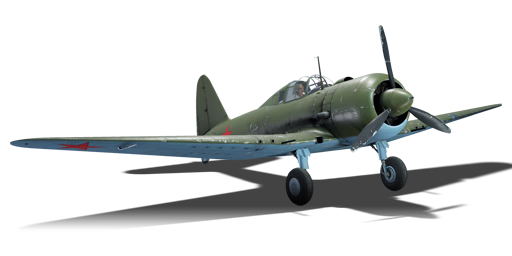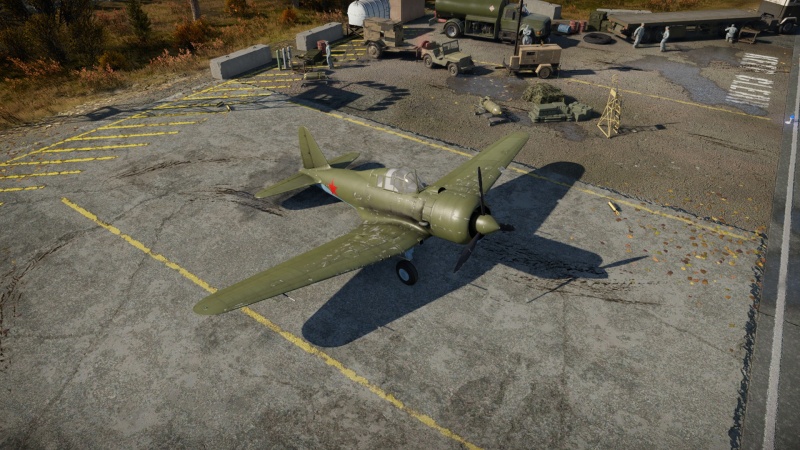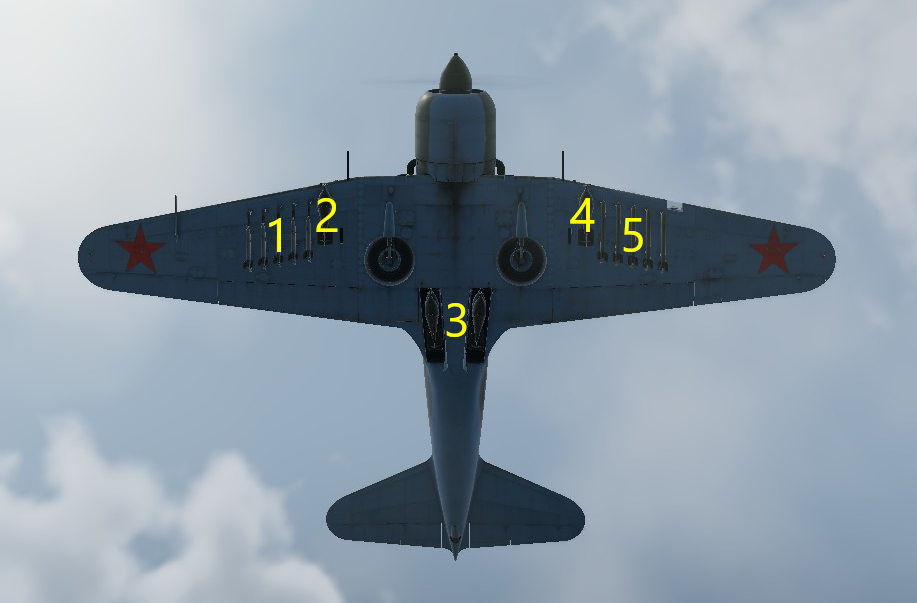Su-6
| This page is about the premium Soviet strike aircraft Su-6. For other versions, see Su-6 (Family). |
Contents
Description
The development of the Su-6 began in 1939 when the Sukhoi design bureau started working on a single-seat ground attack aircraft. The performance of the Su-6 was overall superior to the Ilyushin Il-2 ground attack aircraft, unfortunately the radial engine powering the Su-6 exceeded its age limit before the testing was completed and thus no more engines were available for the aircraft to enter mass production. Thanks to combat experience with the Il-2s, later prototypes were designed with a rear gunner using 12.7 mm Berezin UBT machine gun protecting the rear hemisphere of the aircraft. This meant a decreased bomb load and to counter this, a more powerful engine was installed, the Shvetsov M-71F radial engine. Overall, the Su-6 was faster than the Il-2, however at the expense of carrying a smaller bomb load, the Su-6 never reached production, thanks to its late development and the introduction of the Il-10.
It was introduced in Update "Raining Fire". This Su-6 in particular is the first prototype, the one without a rear gunner and the less powerful M-71 engine. However the Su-6 is still very competitive and capable for its BR. It features a decent flight performance for an attack aircraft, with a mediocre top speed and acceleration but a good turn radius, although the mediocre engine translates to a low rate of climb. It has a very capable armament though, the twin 23 mm cannons are more than enough to destroy unarmoured ground targets and most aircraft in a few bursts with the right ammo. While the ground ordnance is somewhat decent, since neither the bombs or the rockets are particularly large, they should be used with precision.
General info
Flight performance
If you have flown the IL-2, the Su-6 is a very familiar experience, as it shares many of the IL-2's performance characteristics. The greatest improvement of the Su-6 compared to the IL-2 is a much-improved top speed of 491 km/h, almost 100 km/h faster than the ultimate IL-2 variants. Other than that, the aircraft has very similar characteristics to the IL-2: competitive instantaneous turn rate, subpar energy retention in sustained turns (particularly at higher speeds), moderately responsive control surfaces and a decent turn rate.
| Characteristics | Max Speed (km/h at 2,500 m) |
Max altitude (metres) |
Turn time (seconds) |
Rate of climb (metres/second) |
Take-off run (metres) | |||
|---|---|---|---|---|---|---|---|---|
| AB | RB | AB | RB | AB | RB | |||
| Stock | 468 | 451 | 6000 | 23.2 | 24.3 | 6.7 | 6.7 | 500 |
| Upgraded | 515 | 491 | 20.8 | 22.0 | 13.5 | 9.7 | ||
Details
| Features | ||||
|---|---|---|---|---|
| Combat flaps | Take-off flaps | Landing flaps | Air brakes | Arrestor gear |
| ✓ | ✓ | ✓ | X | X |
| Limits | ||||||
|---|---|---|---|---|---|---|
| Wings (km/h) | Gear (km/h) | Flaps (km/h) | Max Static G | |||
| Combat | Take-off | Landing | + | - | ||
| 680 | 330 | 458 | 431 | 290 | ~10 | ~5 |
| Optimal velocities (km/h) | |||
|---|---|---|---|
| Ailerons | Rudder | Elevators | Radiator |
| < 350 | < 380 | < 395 | > 400 |
Survivability and armour
Compared to the IL-2 and IL-10, the Su-6 is much less survivable mainly due to a reduction in armour plating. The aircraft's armour is concentrated around the cockpit, with 12 mm of plating in the lower front and back, 6 mm of plating on the sides, and 65 mm of bulletproof glass in front of the cockpit. Unlike the IL-2 and IL-10, the Su-6's engine block is unarmoured, meaning that head-ons in this aircraft are extremely dangerous due to the risk of engine damage.
The Su-6's main fuel tank is located directly underneath the cockpit and is also covered by the cockpit armour; this fuel tank is also self-sealing and features a neutral gas fire suppression system. The oil cooling system is mounted between the engine and cockpit, but is unarmoured making it more susceptible to damage.
- 6 mm steel behind propeller spinner
- 6 mm steel under oil cooling systems
- 6 mm steel on both sides of fuel tank
- 6 mm steel on both sides of pilot
- 8 mm steel above pilot's head
- 12 mm steel in front of and behind fuel tank
- 12 mm steel behind pilot
- 65 mm bulletproof glass in front of pilot
- Self-sealing fuel tanks (1 underneath pilot)
Modifications and economy
Armaments
Offensive armament
The Su-6 is armed with:
- 2 x 23 mm VYa-23 cannons, wing-mounted (115 rpg = 230 total)
- 4 x 7.62 mm ShKAS machine guns, wing-mounted (750 rpg = 3,000 total)
Suspended armament
The Su-6 can be outfitted with the following ordnance:
| 1 | 2 | 3 | 4 | 5 | ||
|---|---|---|---|---|---|---|
| 25 kg AO-25M-1 bombs | 16 | |||||
| 50 kg FAB-50sv bombs | 1 | 4 | 1 | |||
| 100 kg FAB-100sv bombs | 1 | 4 | 1 | |||
| M-8 rockets | 5 | 5 | ||||
| M-13UK rockets | 5 | 5 | ||||
| RBS-82 rockets | 5 | 5 | ||||
| RBS-132 rockets | 5 | 5 | ||||
| Maximum permissible loadout weight: 517 kg Maximum permissible wing load: 265 kg Maximum permissible weight imbalance: 180 kg | ||||||
| Default weapon presets | |
|---|---|
| |
Usage in battles
Describe the tactics of playing in the aircraft, the features of using aircraft in a team and advice on tactics. Refrain from creating a "guide" - do not impose a single point of view, but instead, give the reader food for thought. Examine the most dangerous enemies and give recommendations on fighting them. If necessary, note the specifics of the game in different modes (AB, RB, SB).
Manual Engine Control
| MEC elements | ||||||
|---|---|---|---|---|---|---|
| Mixer | Pitch | Radiator | Supercharger | Turbocharger | ||
| Oil | Water | Type | ||||
| Controllable | Controllable Not auto controlled |
Controllable Not auto controlled |
Controllable Not auto controlled |
Separate | Not controllable 1 gear |
Not controllable |
Pros and cons
Summarise and briefly evaluate the vehicle in terms of its characteristics and combat effectiveness. Mark its pros and cons in the bulleted list. Try not to use more than 6 points for each of the characteristics. Avoid using categorical definitions such as "bad", "good" and the like - use substitutions with softer forms such as "inadequate" and "effective".
Pros:
- Powerful offensive armament: heavy-hitting 23 mm cannons and fast-firing 7.62 mm machine guns
Cons:
- Slow for its BR: top speed of only 491 km/h
History
The development of the Su-6 began in 1939 when the Sukhoi design bureau started working on a single-seat ground attack aircraft. Two prototypes were ordered on 4th March 1940, with the first of them having its maiden flight on 1st March 1941 with test pilot A.I. Kokin. The performance of the Su-6 was overall superior to the Ilyushin Il-2 ground attack aircraft, unfortunately the Shvetsov M-71 radial engine powering the Su-6 exceeded its age limit before the testing was completed and there were no further M-71 engines available as the engines were never mass produced and only a few were made. The second Su-6 prototype flew only in January 1942 as the Sukhoi design bureau had to be evacuated after the German attack of the Soviet Union. A draft proposing production of 25 aircraft was prepared, but it was never issued.
Combat experiences during the war with single seat Il-2s called for the need of a rear gunner, so the third prototype of the Su-6 was designed with a second crew member utilizing a 12.7 mm Berezin UBT machine gun protecting the rear hemisphere of the aircraft. Due to the addition of the crew member and machine gun with its ammunition, the bomb load decreased from 400 to 200 kg of bombs and the prototype was fitted with a more powerful Shvetsov M-71F engine. The modified Su-6 was 100 km/h faster than the Il-2 at the expense of having a smaller payload. When development of the M-71 engine was cancelled, Sukhoi was ordered to utilize the liquid-cooled Mikulin AM-42 engine. With flight tests beginning on 22nd February 1944, the re-engined Su-6 proved inferior to the Ilyushin Il-10 as it had an additional 250 kg of armour protecting the newly installed engine and lower output compared to the previously used M-71F. The Su-6 never entered production and only 3 prototypes were made. In 1943, Pavel Sukhoi was awarded the Stalin Prize of the 1st Degree for the development of the aircraft.
Media
- Skins
- Videos
See also
Links to the articles on the War Thunder Wiki that you think will be useful for the reader, for example:
- reference to the series of the aircraft;
- links to approximate analogues of other nations and research trees.
External links
| Sukhoi Design Bureau (Сухого Опытное конструкторское бюро) | |
|---|---|
| Jet fighters | Su-9 · Su-11 |
| Su-27 | Su-27 · Su-27SM |
| Strike aircraft | |
| Su-2 | BB-1 · Su-2 (M-82) · Su-2 MV-5 · Su-2 TSS-1 |
| Su-6 | Su-6 · Su-6 (AM-42) · Su-6 (M-71F) |
| Su-7 | Su-7B · Su-7BKL · Su-7BMK |
| Su-8 | Su-8 |
| Su-17 | Su-17M2 · Su-17M4 · Su-22M3 |
| Su-25 | Su-25 · Su-25BM · Su-25K · Su-25T · Su-25SM3 · Su-39 |
| Export | ◊Su-22UM3K · ◔Su-22M3 · ◊Su-22M4 |
| J-11* | |
| *CKD and SKD kits assembled by Shenyang Aircraft Corporation | |
| USSR strike aircraft | |
|---|---|
| IL-2 | IL-2 (1941) · IL-2 (1942) · IL-2M (1943) · IL-2M type 3 · IL-2M "Avenger" · IL-2-37 · IL-2 M-82 |
| IL-8 | IL-8 (1944) |
| IL-10 | IL-10 · IL-10 (1946) |
| Pe-3 | Pe-3 (e) · Pe-3 · Pe-3bis |
| Su-2 | BB-1 · Su-2 MV-5 · Su-2 TSS-1 · Su-2 (M-82) |
| Su-6 | Su-6 · Su-6 (AM-42) · Su-6 (M-71F) |
| Su-8 | Su-8 |
| Tandem MAI | Tandem MAI |
| TIS MA | TIS MA |
| Tu-1 | Tu-1 |
| Yak-2 | Yak-2 KABB |
| USSR premium aircraft | |
|---|---|
| Fighters | Krasnolutsky's I-15bis · I-16 type 28 · Zhukovsky's I-153-M62 · I-153P · I-180S · I-301 · ITP (M-1) |
| LaGG-3-4 · LaGG-3-23 · LaGG-3-34 · Dolgushin's La-7 · La-11 | |
| Eremin's Yak-3(e) · Yak-3 (VK-107) · Yak-3T · Golovachev's Yak-9M | |
| ▂P-39K-1 · ▂Pokryshkin's P-39N-0 · ▂P-39Q-15 · ▂P-40E-1 · ▂P-47D-27 · ▂P-63A-5 · ▂P-63A-10 · ▂P-63C-5 | |
| ▂Hurricane Mk IIB · ▂Spitfire Mk IXc · ▂Fw 190 D-9 | |
| Twin-engine fighters | I-29 |
| Jet fighters | Su-11 · MiG-15bis ISH · MiG-17AS · MiG-21S (R-13-300) · MiG-23ML |
| Strike aircraft | IL-2M "Avenger" · IL-2 M-82 · IL-8 (1944) · Su-6 · Tandem MAI · TIS MA · Su-8 · Tu-1 |
| Yak-38 · Su-7BMK · Su-25K · Su-39 | |
| Bombers | Po-2M · Be-6 · MBR-2-M-34 · Pe-2-205 · TB-3M-17-32 |
| ▂PBY-5A Catalina · ▂Hampden TB Mk I · ▂A-20G-30 · ▂B-25J-30 | |






